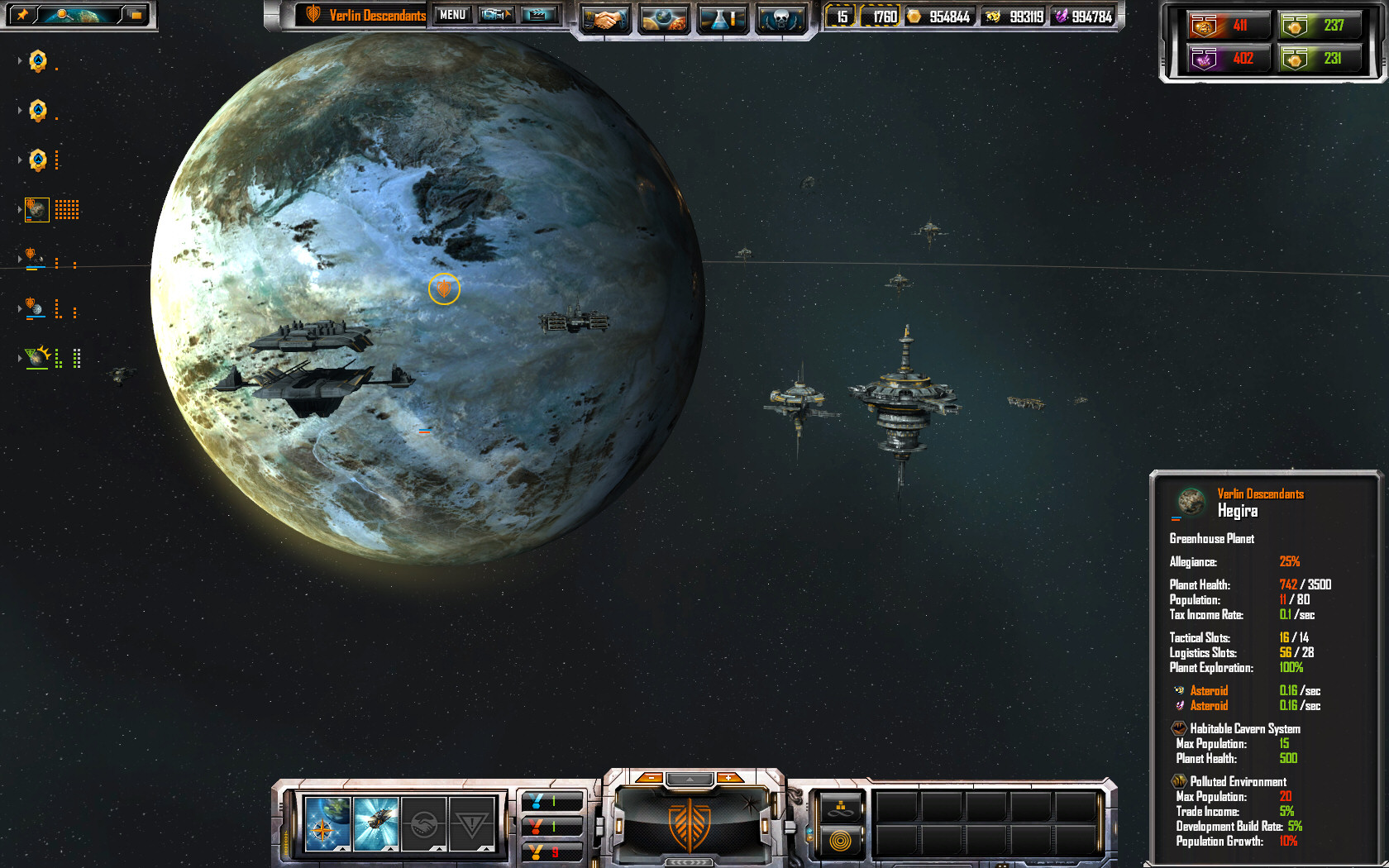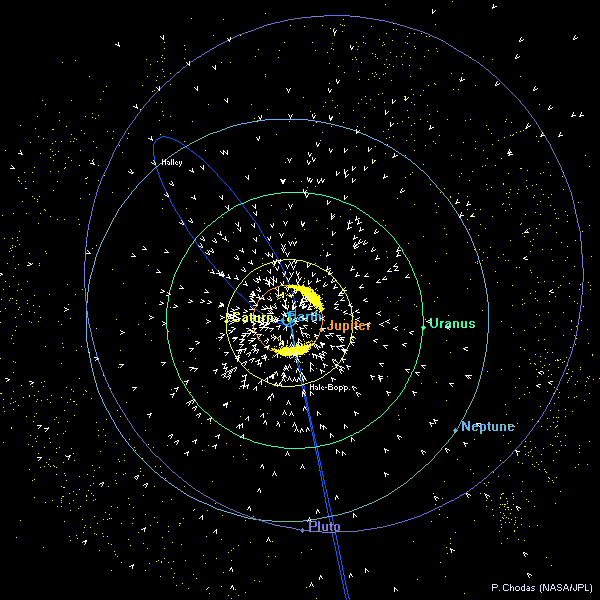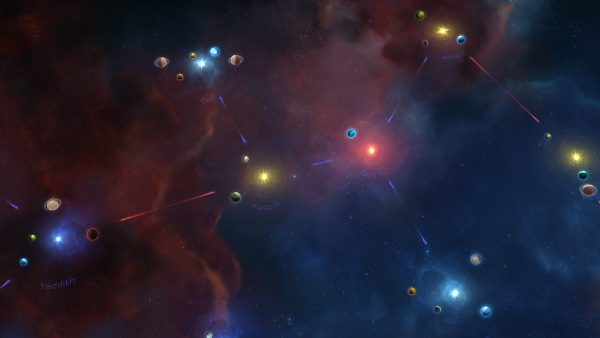
Okay, so admittidly it is better than


First off, the good: Schema, your way of making boxes of space is good, the sectors in a 16^3 space is a system, and systems being a logarithmic unit of navigating the galaxy with is useful.. In fact, it is logarithmic "steps" like these, that starmade needs to allow players to navigate the universe. The systems themselves are arranged into abstract shapes that look like they might be cosmic structures, and bring order to the universe.
Now, what we have is this is a VERY clunky system. The main criticisms I have also rely on whether you wish this game to continue to be arcade-y with cartoon-y microscopic solar systems and "galaxy's" that are currently bad jokes.
Schine, you have only 2 units, sectors and systems, and make it hard to navigate around inside of the universe you created. To examine the other side of the galaxy you need to hold shift and rapidly tap w,a,s,d,e, and q to move your camera over. Or you could try to double-click on a object like a star (or object in the system) but if there is another object directly behind it then it seems it focuses on whatever you didn't wish to look at.
The amount of tools you have at your disposal is pretty much getting the names of objects by moving your mouse cursor over them and also selecting a sector. Very limiting and disappointingly sparse.
First off, we need to break down sectors and systems and rethink how to use them.
The most basic and smallest unit is the block, and a sector has been typically made up of 2000x2000x2000 blocks, although most prefer to go larger when setting up servers. Physically (well technically its virtually) traveling in the game involves you moving around these grids until you hit the edge of that grid, and move to another grid, usually seamlessly now.
Fields

The sector, which we will need to rename, for now Field (place holder, but I have the word sector coined for another step. What about Zone? Acre? Tract? Plot?) would be the second smallest unit, and the smallest unit of the galactic map that one can work with. It is one of the most noticeable units of space that would impact players, one could be inside of a star or in total vacuum depending on the Field type, and they would all have their own set of BIOMES and RULES to adhere to. Each Field would be functionally identical to what we have today in other aspects. They could contain planets, gas giants, moons, asteroids, rings, space stations, or nothing... They are the most down to earth component and interacted with the most, while the others are more abstract and like borders drawn on a map.
Neighborhoods
The system will have the most fundamental changes to it, as I will be reworking it entirely. Now, to preserve the positional code, each system; or as we will be referring to them, Neighborhoods (or Quadrants, Range, Section, Stratum?) would contain 16^3 Fields. Neighborhoods would be a less tangible thing, and just an easy way to maneuver around in the map view to get from one side of the System to the other. Neighborhoods would be a subdivision of the new Systems, which would be a 4x4x4 of Neighborhoods. This vastly increases the size of solar systems we have to work with, and gives us a HUGE amount of creative freedom to work with. Neighborhoods would not have biomes nor would they effect the Fields inside of them. When looking in the map at Fields (like the sectors we look at now) we can use shift+movement keys to quickly move our point of focus around the System's 4x4x4 boxes. To recap, it is a less tangible unit of measurement and used out of convenience for moving around in systems and out of nessesity for the code. After all, it is a damn fine foundation. Players when moving from Neighborhood to Neighborhood would not feel anything different like moving from Field to Field or across System Boundaries to other Systems, and the boundaries looking at the most zoomed in System mode are not necessarily visible unless holding shift when fast traveling around the System.
Systems:





>Sensors detect a hostile fleet entering your System
>Sensors detect a hostile fleet entering your System
>Sensors detect a hostile fleet entering your System
>Sensors detect a hostile fleet entering your System
>Sensors detect a hostile fleet entering your System
>Sensors detect a hostile fleet entering your System
>Sensors detect a hostile fleet entering your System
>Sensors detect a hostile fleet entering your System
>Sensors detect a hostile fleet entering your System

*Flight of the Valkyries plays*
DOOOOVVVVVIIIIIAAAAAAANNNNNNNNSSSSSS!!!!!!
Now, originating from the star is a series of spheres to form a type of "Heat" gradient out though the system.
- First their is the star itself, I would never recommend actually entering the star as it will vaporize your ship through the energy held in the plasma and the gravity/pressure/radiation of being in that situation.
- Then we have the Burn Zone, to make a comparison to our own solar system, this would fall well within the orbit of Mercury. It would function sort of similar to what we have now, with ships being damaged traveling this close to their sun. No asteroids or stations would generate in this shell, but in the discussion of anomalies, you could have Hot Jupiter's, Hot Neptune's, or even rocky planets frozen in their death spiral inhabiting this shell. Elliptical orbits could also carry objects into this zone theoretically, most common and abundant of this example would be comets.
- Next is the Evaporate Zone (name pending), a hellish place where rivers of molten rock flow on the surface of planets. Significantly cooler than the Burn Zone however! Generally planets like mercury could be found here, barren and cratered, with no atmosphere and slow rotation/tidally locked to the host star. If flares are ever implemented, then this is not a place to hang out when activity starts up.
- And now we have our favorite temperature sphere, the Habitable Zone. In the inner edge, dry desert planets like mars would be habitable to life while potential ocean planets like would puff like Venus. On the outer edges of the Habitable zone, Oceanic worlds with their thick atmospheres would be still habitable while desert planets would turn into ice balls. The "frost line" would also exist inside of the habitable zone, where solid ice would be able to persist while being exposed to sunlight without sublimating. In our own solar system, this band would streach from the inside of Venus's orbit to half way to Jupiter, encompassing Mars and some of the asteroid belt.
- The Gasses Zone would be the typical romping ground for gas giants like Jupiter and Saturn. This band would have plenty of ices like water ice, dry ice, and other low freezing point volitiles, but still be too warm for frozen nitrogen and methane.
- The Ices Zone would be an analog to where our own ice giants reside, Uranus and Neptune, and would be cold enough to have the majority of the rest of the stuff we think of as gases to be frozen and soild as ice, with water ice functioning as basically rock (white shiny rock) like our silicate rocks we have here on earth.
- Those are the shells close enough to the star to have "normal" planets, that are in the orbits that they formed in, every other shell from here on out will be what is beyond that. First is the Kuiper Belt of Star Systems, the scattered disk, the remnants of the very outer edge of the accretion disks, the belts of materials thrown out when the planets formed (specifically the gas giants) and while it holds a huge amount of material, it has an even larger amount of volume. It could be that there are rocks in every Field of the Kuiper Belt, but most of the time it is just one or two asteroids or comets (icy asteroids) with maybe a very small (5% or less) chance of having more than 2. This area is a haven for dwarf planets; moon sized objects that orbit in strange paths compared to the near circular orbits we are used to thinking about when we think about planets.
- Past that is the heliopause, and a open shell before you get to the last shell that also contains the Oort Cloud. In the Oort cloud you get a chance of a rock per Field, it will take vast tracks of space to be mined before you get a sizable sum of resources, but it is still way more efficient than mining in void space or in nebulae.
I have another whole segment that would really flesh this idea out more and involve multi-star systems, which would end up being the slight majority of all systems out there. Currently Systems contain 1-2 belts and an average of 3 planets, I would hope that in a redesigned universe a fleshed out solar system would potentially have hundreds of objects that are not just stations but naturally formed bodies to explore, name, and exploit (or you could have your fleets/friends go do that for you).
Sectors:




Sectors contain a 16x16x16 box of Systems, which is also a 64x64x64 box of Neighborhoods, and also a 1024x1024x1024 box of Fields, to put it in perspective. These are the units in the galactic view that make up a galaxy. Where they are in the galactic sense determines the biome consistency of the Systems inside of them. Once again, I have a whole other section I will dedicate to this project.
- For example, sectors in the galaxy arms will have great looking nebulae, and big bright young stars.
- Globular clusters and the bulge of galaxies and center of elliptical galaxies would have dusty, old, puffed up stars, packed very close together with little to no void systems.

Our own galaxy arms with the local group in the center of the image. The space between galaxy arms is filled with the same amount of stars, but the arms have the new born stars, the giant (short lived) stars, and the concentrated gas and dust which makes pretty background nebula.
Then we have the types of galaxies, the types of objects that orbit galaxies, and dwarf galaxies.
But that is a thread for another day.

